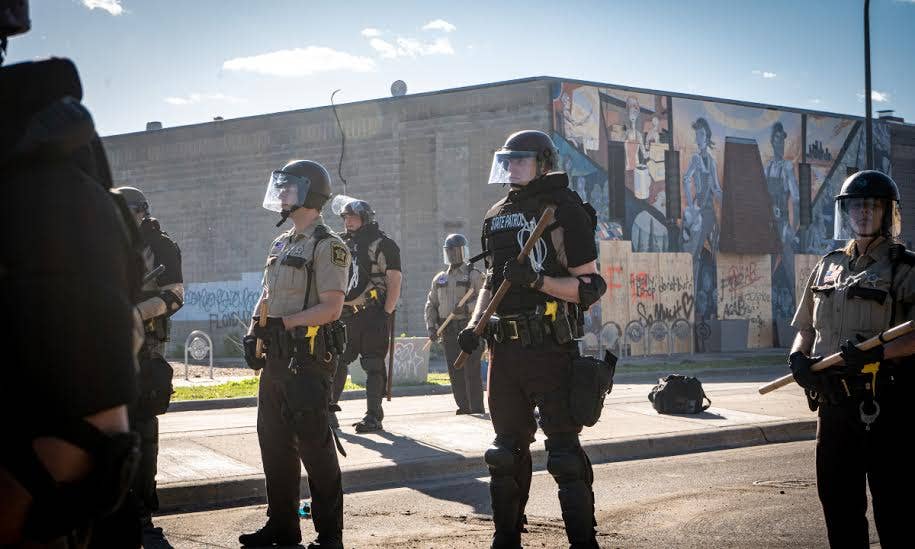What Is Kettling? Understanding The Controversial Police Tactic
The term originated in Germany.
 MUNSHOTS / Shutterstock
MUNSHOTS / Shutterstock The recent on-going Black Lives matter protests have provided an education about both racism and policing for many people in America. From learning that chokeholds are accepted practices to hearing shockingly upsetting and disturbing stories about police interactions with our BIPOC friends and neighbors, many of us are having to adjust and expand our thinking in many ways.
One of the things we've all learned recently is that police have a lot of methods of crown control — and some of them are controversial. Tear gas and rubber bullets are well-known and discussions about them have been going on for years. But most of us had never heard the term "kettling" until recently.
What is kettling?
The controversial crowd control method has been used in various cities recently and it has raised a lot of questions about why it is done.
Where did the word kettling come from?
Kettling comes from the German word "kessel", which means cauldron. It referred to a German military tactic of surrounding enemy forces on all sides, leaving them with no path to escape.
If the idea of a police technique being based on German military tactics makes you uncomfortable, you're not alone. The way the tactic is sometimes used is considered dangerous and detrimental to First Amendment-protected protests and demonstrations in public spaces.
How is kettling used in U.S. police forces?
The way U.S. law enforcement uses kettling is to basically herd a large crowd into a space where they can't escape, such as a bridge with both ends blocked off or a dead-end street. They can also force crowds into an intersection and control all four sides such that no one can get past police barricades.
It's the opposite of dispersement tactics, which usually seek to moves crowd by sending people into many different directions and diffusing the number of people in a space. Kettling, instead, traps all the people in one smaller area that is controlled by police.
Why is kettling problematic?
The problem with kettling arises when police don't allow crowds to leave once they've been trapped. For example, in early June, police trapped over 5,000 demonstrators on the Manhattan Bridge in New York City for over an hour. The people were unable to leave and unable to access restrooms, food, water, or first aid during the entire time they were on the bridge span. Police took the action because the demonstrators were breaking the curfew in the city that night but, even when they were allowed out through checkpoints, protesters feared they would be arrested because the action kept them out even later.
In Washington DC, cops herded protesters onto a short residential block and were preparing to arrest them all for curfew violations. People who lived on the block started allowing protestors to shelter in their homes, which put them in compliance with the curfew but cops kept trying to lure them back onto the streets. Once curfew was listed the following morning, the protestors were able to return to their homes.
Protestors were not allowed off the bridge.
Is kettling "criminalizing existence in public spaces"?
There's an argument that all the protestors in these cases were automatically breaking the law since they were violating a curfew set by their cities. But that isn't always the case in situations where police compress demonstrators into a controlled space. There are instances when a combination of peaceful and non-peaceful protestors get caught in a kettling situation and there's no mechanism the police use to differentiate between them.
“Kettling is a law enforcement tactic specifically applied when the police have chosen to criminalize existence in public spaces,” says Blake Strode, Executive Director of ArchCity Defenders, a legal advocacy group in St. Louis. “So separate and apart from who is caught in them and how people are impacted, which is all true and well-stated, it is also fundamentally about police dictating whom is allowed to be where and when.”
But does it work?
In terms of controlling the location of a crowd and keeping them from moving into other parts of a city and doing damage, yes, kettling is effective. In terms of reducing tension, no, it doesn't really work. “The tactic of completely surrounding a group of civilians leads to panic and increases the likelihood of a physical confrontation between the citizens and the police,” ArchCity Defenders attorney Maureen Hanlon told reporters. At a New York Cty protest earlier this month, when police hemmed in a group of peaceful protestors who weren't aware they were being surrounded. As the protestors tried to leave, police escalated their crowd control to violence and beat some demonstrators with batons.
What can you do if you're caught in a kettling situation?
There doesn't seem to be a place to stop police from kettling demonstrators. Mayor DiBlasio even defending the technique. Experts say that anyone participating in a public demonstration should do their best to stay aware of what's going on around them. If you start to worry that you're being herded into a space to be trapped by police, start looking for an exit route right away. Don't confront cops in that situation; just try your best to get yourself to safety before things get too difficult.
Rebekah Kuschmider has been writing about celebrities, pop culture, entertainment, and politics since 2010. She is the creator of the blog FeminXer and she is a cohost of the weekly podcast The More Perfect Union.

